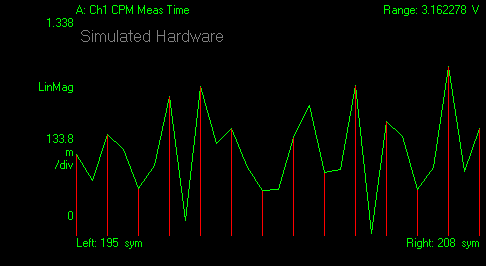Points / Symbol (Digital Demod)
determines the number of points displayed between symbols for digitally demodulated data.
|
1 point per symbol |
|
|
Minimum (OQPSK): |
2 points per symbol |
|
Maximum: |
20 points per symbol |
|
EDGE Enhanced Data for Global Evolution: A technology that gives GSMA and TDMA similar capacity to handle services for the third generation of mobile telephony. EDGE was developed to enable the transmission of large amounts of data at a high speed, 384 kilobits per second. (It increases available time slots and data rates over existing wireless networks.) default (see Additional Detains below): |
1 point per symbol |
For example, if the value of is 1, each display point corresponds to a symbol. If the value is 2, every other display point corresponds to a symbol In this case, an IQ time trace would show 1 display point between each symbol, as shown in the following illustration.

The effect of can be seen by displaying an IQ trace and pressing an arrow key (on the keyboard) or turning the mouse wheel to move the marker between symbols. If the number of points per symbol is 2, moving the marker would reveal 1 distinct display points between symbols.
For details about IQ diagrams, see IQ (Polar) Diagrams.
Additional Details
Here are some additional details:
- Measurement Effects: For details about how affects measurement data, see IQ Meas Time.
- Saving Points / Symbol: When a digitally demodulated trace is saved , the value used to create the trace is saved with the trace. When the trace is recalled, the VSA displays the trace with the used to create the trace. The VSA DOES NOT use the current value of .
- OQPSK Demodulation: For OQPSK, an even number of are required due to the offset between I and Q. If an odd value for is specified, the VSA chooses the next lower even value.
- EDGE demodulation: For the EDGE demodulation format, the is set to 1 (default). The , , and trace data results are the ISI Inter-Symbol Interference: An interference effect where energy from prior symbols in a bit stream is present in later symbols. ISI is normally caused by filtering of the data streams. (inter-symbol interference) compensated values. That is, when the points/symbol is set to 1 (default), the VSA removes the effects of ISI (inter-symbol interference), which provides a "clean" constellation diagram. For points/symbol greater than one, the trace data results are not compensated for the effects of ISI. For values greater than 1 point/symbol, the symbols in EDGE constellation diagrams may appear randomly placed due to the effects of ISI.
- Couple to Gain Imb. / Quad Skew: This measurement parameter selection controls the number of used to calculate the IQ Gain Imbalance and Quadrature Skew symbol error data results. For further information, see Couple to Gain Imb. / Quad Skew, IQ Gain Imbal, and Quad Err.
Also, see the Error Summary Data topic, Error Information at Symbol Times section.
See Also
